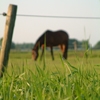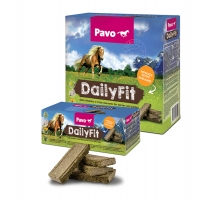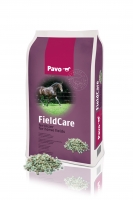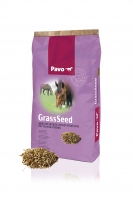Pasture management for horse fields
Every now and then, your fields need rejuvenating. You can do that by completely seeding after ploughing the fields or by reseeding the existing grassland. Following are some tips and advice on grassland maintenance for your fields, separated into maintenance and fertilising.
Maintenance of the fields
The following points are important for keeping your fields in good condition:
1. Seeding / re-seeding of the fields
Try to renew your grass every 10-15 years, by completely redoing the fields or, at least, by re-seeding. After ploughing and rolling and before seeding the new grass, you should carry out a repair fertilising. This is very important. You need a soil analysis to find out the deficiencies of the soil. After adding the required ingredients, you can go ahead with the seeding. Use grass seed for horse pasture and not for cattle pasture.
If you decide to re-seed, then the grass seeds need to go onto the existing grassland. The best time for seeding is autumn or spring. Summer is less suitable.
2. The grass seed mixture: suitable for horses
There are some standard seed mixes commercially available for horse fields in England. It consists of perennial ryegrass (3 to 4 varieties), meadow fescue, Timothy (2 varieties), creeping red fescue and smooth stalked meadow grass. You need around 14 kg per acre.
Ryegrass is less suitable for horses as it grows very fast and overgrows the finer grasses, which horses prefer. Ryegrass also contains a high level of protein, which is good for cows (milk production), but not required for horses. Horses need a more structure rich type of grass.
Creeping red fescue is one of the best grasses for horse fields and it is recommended to put a mix together yourself without any ryegrass. A standard mix should contain creeping red fescue (4 kg/acre), crested dogstail (2 kg/acre), Timothy (1 kg/acre), smooth stalked meadow grass (1 kg/acre) and cocksfoot (0.5 kg/acre). Ideally you would add some herbs and wildflowers. The grassseed for horses: Pavo Horse Grass Seed
3. Grazing and topping
It is recommended to top the fields every now and then between periods of grazing. This will maintain the good quality of the fields.
4. Remove droppings from the fields
Every horse owner knows this, but it is not always done: droppings should be removed every day. Especially to prevent worm contamination, but also to avoid the rough vegetation appearing in the latrines (areas used by horses for both urinating and manuring).
5. Pasture maintenance
It is recommended to top the fields every now and then to get rid of the rough vegetation and to harrow the fields at least once a year.
Fertilising the fields
In general, fertilising the fields is not getting the attention it deserves. It is an exception that the owner of the fields takes soil samples to find out what the state of the soil is and to put a fertilisation plan together. However, it is important for the quality of the fields and the health of the horse to provide the soil with the correct fertiliser. Below are a few tips and advice.
Limit the amount of organic manures
Organic manure, from animals, has an excellent fertilising value. The benefit is that organic manure releases the effective ingredients slowly, so that the fields benefit for the whole grazing season. In general, 10 cubic meters is sufficient for 2.5 acres. The reason is the high percentage of potassium in organic manure. Too high a percentage of potassium in the soil prevents grasses from absorbing magnesium and other minerals which are important for horses.
Provide a steady level of nitrogen
A lot of field owners spread an artificial fertiliser in the spring. The fertiliser used normally contains Nitrogen, Phosphate and Potassium. The nitrogen releases within a few days and causes the grass to grow very quickly. As a result the grass contains high levels of protein, not wanted for horses!!
A few years ago Pavo FieldCare came on to the market, which contains a special nitrogen combination, which releases the nitrogen slowly (normally 2 to 3 months). This type of nitrogen is called ENTEC-nitrogen and is manufactured by BASF. The benefits are that the grass grows well, but the protein levels stay low. It also does not dissolve easily in rainwater, so it does not flush away and is better for the environment.
Phosphorus supplement in spring
Phosphorus is important for the initial growth of the roots, which the young grass uses to collect the nutrients from the soil. Weeds and unwanted grasses find it difficult to grow in a good phosphate environment.
Also, phosphorus is an important building block for the development of the bones in a horse. The phosphorus present in the soil is difficult to obtain by the young grass, so it is important that the fertiliser contains phosphorus: for the grass root development and for the healthy bone growth of the horse.
Magnesium is often overlooked
Magnesium is an important building block for the development of green leaves. Also, the magnesium requirement of horses is quite high. In general, the levels of magnesium in the soil are low or the potassium levels are high, so it is difficult to absorb magnesium. Therefore it is important to add magnesium to horse fields.
Agricultural salt on a horse field?
Sodium plays an important role in the attractive taste of grass. It does not increase the growth, but makes the grass attractive to horses. Horses who work a lot need a lot of sodium (salt). By spreading a limited amount of agricultural salt on horse fields you improve the taste and give the horses a bit of extra salt.
Spreading lime in the autumn
Most soil samples of horse fields show a very low pH value. The soil is acidic. In an acidic field, it is more difficult for plants to absorb nutrients. You can repair an acidic field by spreading lime from September to November. The pH of the soil will then be neutral again in spring when the grass starts to grow.
Summary
- Grassland renovation: seed or re-seed every 10-15 years
- Use a grass seed mix suitable for horses
- Top the fields between periods of grazing
- Remove droppings from the fields
- Organic fertiliser (animal manure) is excellent for the field, but limit the amount
- Use a fertiliser with slow releasing nitrogen which keeps the protein level low
- Pay attention to the magnesium and sodium levels in the fields
- Control the pH value of the fields by spreading lime in the autumn
You can always contact us when you have any questions, like how to interpret the results of your soil samples. We can advise you on the maintenance of your fields.
An excellent reference book is ‘Managing Grass for Horses’ by Elizabeth O’Beirne-Ranelagh, published by J.A. Allen in London, ISBN 0 85131856 8






